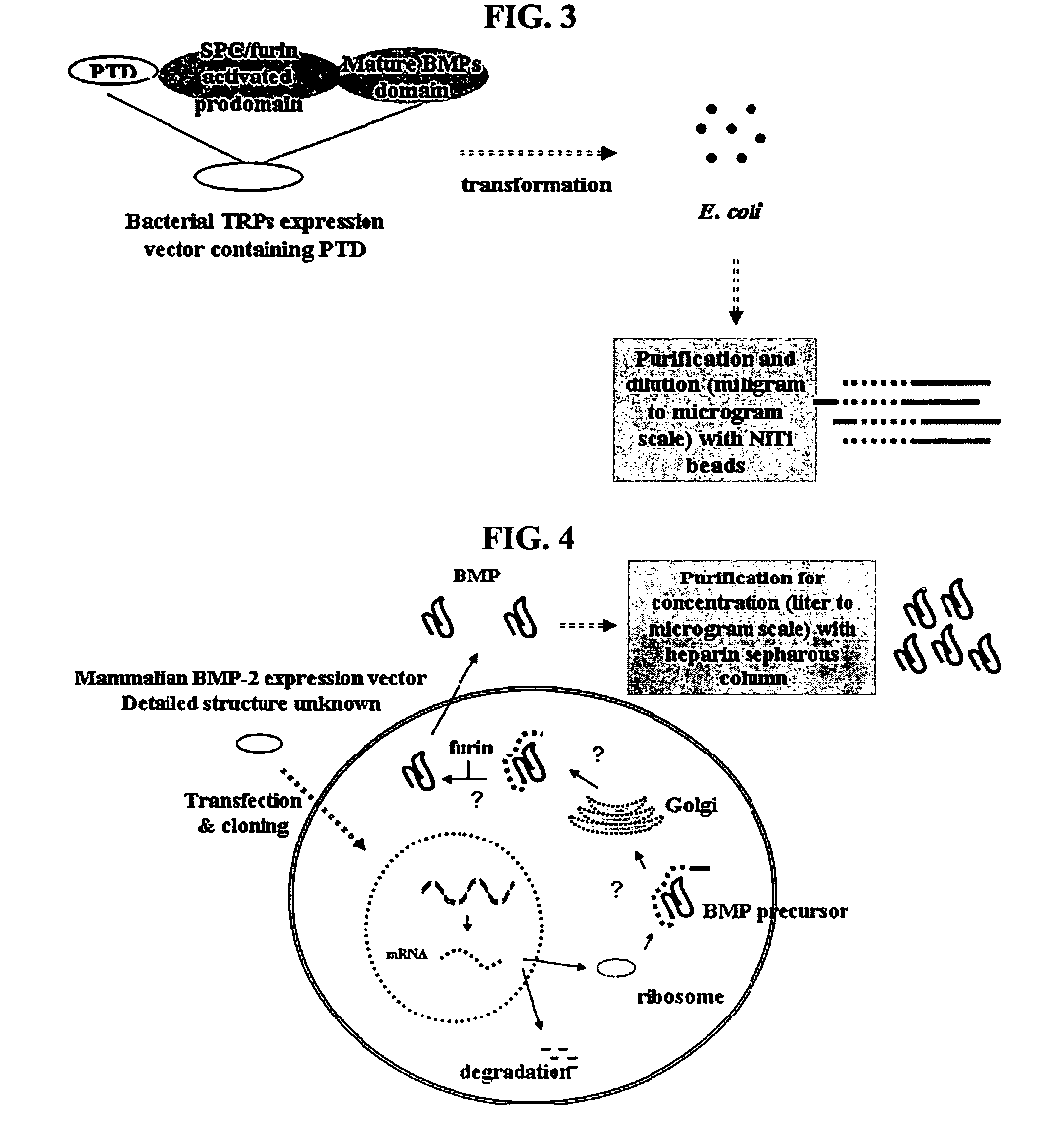Non-activated polypeptides having a function of tissue regeneration and method for preparing the same
- Summary
- Abstract
- Description
- Claims
- Application Information
AI Technical Summary
Benefits of technology
Problems solved by technology
Method used
Image
Examples
example 1
[0092] Preparation of ITAT-hBMP2] fusion polypeptide
[0093] Each of proteins belonging to a BMP / TGF-β group consists of a dimer comprising the same two peptides linked to each other by one disulfide bond. In this regard, each of the peptides consists of 120-140 amino acids depending on the type of BMPs, one of 7 cystein terminal groups present in BMPs forms a disulfide bond with the same site of the other peptides to form a dimer, and the remaining 6 cysteins form 3 intrachain disulfide bonds in the same amino acids, resulting in a unique three-dimensional structure (Proc. Natl. Acad. Sci., 93:878, 1996; J Bone Joint Surg., 83:S1, 2001). Herein, BMP2 consists of 114 amino acids, BMP7 consists of 139 amino acids, and each of TGF-β and β3 consists of 112 amino acids. FIG. 1 shows the amino acid sequences of these peptides and a schematic diagram of the three-dimensional structure thereof, and FIG. 2 shows the three-dimensional structure of previously known BMP2 (Eur. J Biochem., 237:2...
example 3
[0113] Cleavage and activation of TRP-1 bv proprotein convertase
[0114] In order to examine whether the inventive non-activated TRP-1 is cleaved and activated by furin in cells, TRP- 1 prepared in Example 2 was cleaved in vitro using a recombinant furin protein (Sigma, USA). As a result, as shown in FIG. 15, TRP-1 was successfully cleaved in vitro by the furin.
[0115] Also, in order to examine whether the inventive non-activated TRP- 1 is activated by furin in cells, intracellular furin was inhibited using aL antitrypsin Portland (α1-PDX) expression vector (Proc. Natl. Acad. Sci., 95:7293, 1998), as a furin inhibitory protein. Because the inventive non-activated TRP-1 is converted to a biochemically active protein after introduction into cells, the amount of TRP- 1 initially introduced into cells shall gradually decrease at a given time after the administration of TRP-1. Thus, it can be expected that, when furin is inhibited by inducing the expression of α1-PDX, the remaining amount...
example 4
[0117] Importance of FAD in activation of TRP-1
[0118] It was confirmed through Examples 2 and 3 that TRP-1 is cleaved and activated by furin in cells. Thus, it can be expected that FAD and the furin cleavage site will play an important role in making the TRP-1 to show biological activity after administration into cells.
[0119] To confirm this expectation, TRP-1 obtained in Example 2 and its variants were added to primarily cultured fibroblasts and observed for ALP activity and the deposition of mineralized substances (FIG. 17). TRP-1 and its variants were measured for alkaline phosphatase (ALP) activity in the same manner as in Example 1, as a result, as shown in FIG. 17, TRP-1 (TAT-FAD-hBMP2) showed high ALP activity, and the TRP-1 variant [Δ(Sig)] from which a signal peptide has been deleted showed a similar or higher activity than that of TRP- 1. These results indicate that the signal peptide is not necessary for the activation of BMP2 by TAT and FAD. However, it can be seen tha...
PUM
| Property | Measurement | Unit |
|---|---|---|
| Composition | aaaaa | aaaaa |
| Biological properties | aaaaa | aaaaa |
Abstract
Description
Claims
Application Information
 Login to View More
Login to View More - R&D
- Intellectual Property
- Life Sciences
- Materials
- Tech Scout
- Unparalleled Data Quality
- Higher Quality Content
- 60% Fewer Hallucinations
Browse by: Latest US Patents, China's latest patents, Technical Efficacy Thesaurus, Application Domain, Technology Topic, Popular Technical Reports.
© 2025 PatSnap. All rights reserved.Legal|Privacy policy|Modern Slavery Act Transparency Statement|Sitemap|About US| Contact US: help@patsnap.com



